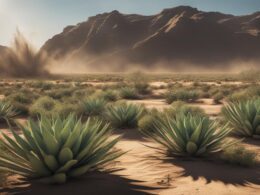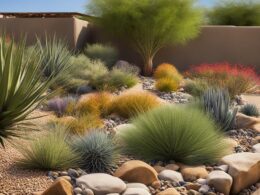Mulch is a vital component of xeriscaping, a landscaping approach that focuses on water conservation. It helps retain soil moisture, reduce evaporation, control weeds, and improve the overall appearance of a drought-tolerant landscape. There are various types of mulch to choose from, including organic options like wood chips, bark, grass clippings, and leaves, as well as inorganic options like rocks and gravel.
Key Takeaways:
- Choosing the right mulch type is crucial for xeriscapes.
- Mulch helps retain soil moisture and reduce evaporation.
- Organic mulch options include wood chips, bark, grass clippings, and leaves.
- Inorganic mulch options include rocks and gravel.
- Consider factors like aesthetics, plant requirements, and climate when selecting mulch.
Understanding the Benefits of Mulch in Xeriscapes
Mulch plays a crucial role in xeriscapes by providing several benefits. It helps conserve water by reducing evaporation and improving soil moisture retention. Mulch also acts as a natural weed suppressant, reducing the need for herbicides and manual weeding. Additionally, it helps regulate soil temperature, protecting plant roots from extreme heat or cold.
By retaining moisture in the soil, mulch aids in water conservation, ensuring that the plants in xeriscapes receive the necessary hydration while minimizing water waste through evaporation. The layer of mulch acts as a barrier, preventing rapid moisture loss and allowing the soil to retain its moisture content for longer periods. This is especially important in arid climates where water scarcity is a concern.
In addition to water conservation, mulch serves as an effective weed control method. By smothering weed seeds and preventing sunlight from reaching them, mulch inhibits weed germination and growth. This reduces the need for chemical herbicides and manual weeding, making xeriscapes a low-maintenance landscaping option. With the proper thickness and coverage, mulch creates an unfavorable environment for weeds to establish and thrive.
“Mulch helps regulate soil temperature, protecting plant roots from extreme heat or cold.”
Mulch also contributes to temperature regulation in xeriscapes. In hot climates, a layer of mulch shields the soil from direct sunlight and insulates it, preventing excessive heat from penetrating the root zone. This helps keep the soil temperature cool and reduces the risk of heat stress to plants. In colder regions, mulch acts as an insulator, protecting plant roots from freezing temperatures, ensuring their survival during winter months.
| Benefits of Mulch in Xeriscapes |
|---|
| Conserves water by reducing evaporation |
| Improves soil moisture retention |
| Acts as a natural weed suppressant |
| Regulates soil temperature |
Organic Mulch Types for Xeriscapes
The use of organic mulch in xeriscapes offers numerous benefits, including improved soil health and natural aesthetics. There are several organic mulch options that are particularly well-suited for xeriscapes, including wood chips, bark, grass clippings, and leaves. Each of these options has unique characteristics and advantages that can enhance the overall effectiveness of a xeriscape landscape.
Wood chips: Wood chips are a popular choice for organic mulch in xeriscapes. They provide long-lasting coverage and can help suppress weeds effectively. Wood chips also break down slowly, which means they require less frequent replenishment. Additionally, as they decompose, wood chips add organic matter to the soil, improving its structure and fertility.
Bark: Bark mulch is another common organic option for xeriscapes. It is available in different textures and colors, allowing homeowners to select the most visually appealing option for their landscape. Bark mulch helps retain moisture in the soil and acts as an insulator, protecting plant roots from extreme temperatures. It also adds a natural, earthy look to the xeriscape.
Grass clippings and leaves: Grass clippings and leaves can be used as organic mulch in xeriscapes. These materials break down quickly, adding valuable nutrients to the soil. Grass clippings and leaves also act as a natural weed suppressant, reducing the need for additional weed control measures. However, it’s important to avoid using thick layers of grass clippings, as they can create a dense mat that may hinder water penetration.
| Mulch Type | Advantages | Considerations |
|---|---|---|
| Wood chips | – Long-lasting coverage – Effective weed suppression – Adds organic matter to the soil |
– Requires less frequent replenishment – May take longer to decompose |
| Bark | – Retains moisture in the soil – Acts as an insulator – Adds natural, earthy look to the landscape |
– May be more expensive than other options – Can wash away easily in heavy rains |
| Grass clippings and leaves | – Quick decomposition adds nutrients to the soil – Acts as a natural weed suppressant |
– Avoid thick layers that hinder water penetration – May require more frequent replenishment |
When using organic mulch in xeriscapes, it’s essential to replenish the mulch regularly to maintain its effectiveness. This may involve adding a fresh layer of mulch every year or as needed. By selecting the appropriate organic mulch type for your xeriscape and properly maintaining it, you can create a sustainable and visually appealing landscape that thrives in water-limited environments.
Inorganic Mulch Types for Xeriscapes
Xeriscapes can benefit greatly from the use of inorganic mulch options. When choosing the right type of mulch for your xeriscape, it’s important to consider the advantages of inorganic mulch, such as rocks, gravel, and pebbles. These materials provide unique benefits that can help create a low-maintenance and visually appealing landscape.
The Benefits of Inorganic Mulch
Inorganic mulches like rocks, gravel, and pebbles offer several advantages for xeriscapes. One of the primary benefits is their durability. Unlike organic mulches, inorganic options do not decompose over time, meaning they will last longer and require less frequent replacement.
Additionally, inorganic mulches provide excellent weed control. Their dense and solid nature creates a barrier that prevents weed growth and competition for resources. This reduces the need for herbicides or manual weeding, saving you time and effort in maintaining your xeriscape.
Choosing the Right Inorganic Mulch
When selecting inorganic mulch for your xeriscape, consider the size and color of the materials. Larger rocks or gravel can be used to create focal points or pathways, while smaller pebbles can be used to fill in gaps between plants or cover larger areas.
The color of the mulch should also be considered to ensure it complements the overall design and aesthetic of your xeriscape. Natural earth tones like shades of brown or gray are popular choices, but you can also explore bolder colors like red or white for a more striking visual impact.
Remember to take into account the specific requirements of your plants and the climate of your region when choosing inorganic mulch. Consider factors such as drainage, heat retention, and water conservation to ensure the most suitable option for your xeriscape.
| Benefits of Inorganic Mulch for Xeriscapes | Advantages |
|---|---|
| Longevity | Inorganic mulches like rocks, gravel, and pebbles do not decompose, providing long-lasting coverage. |
| Weed Control | The density of inorganic mulches creates a barrier that suppresses weed growth, reducing the need for manual weeding. |
| Visual Appeal | Inorganic mulches can enhance the aesthetic of your xeriscape with their unique textures, colors, and sizes. |
| Heat Regulation | Rocks and gravel can help regulate soil temperature, protecting plant roots from extreme heat or cold. |
| Water Conservation | Inorganic mulches reduce evaporation, helping to conserve moisture in the soil and reduce water requirements. |
Selecting the Best Mulch Type for Your Xeriscape
When creating a xeriscape, choosing the right mulch type is crucial for the success of your landscaping project. Consider the following factors to ensure you select the best mulch option for your xeriscape:
Aesthetic:
Take into account your personal preferences and the visual appeal you want to achieve in your xeriscape. Organic mulches like wood chips and bark offer a natural and rustic look, while inorganic options like rocks and gravel can provide a more modern and minimalist aesthetic.
Plant Requirements:
Consider the specific needs and requirements of the plants in your xeriscape. Some plants may benefit from organic mulches that provide additional nutrients to the soil as they break down. Others may thrive better with inorganic mulches that provide excellent drainage and weed control.
Climate:
Take into account the climate of your region and how it may impact the effectiveness of different mulch types. In hot and arid climates, organic mulches can help retain soil moisture, while in cooler climates, inorganic mulches can help regulate soil temperature.
By considering these factors, you can select the best mulch type that not only meets your aesthetic preferences but also supports the health and growth of your plants in the specific climate of your region.
Table: Mulch Types for Xeriscapes
| Mulch Type | Aesthetic | Plant Requirements | Climate Suitability |
|---|---|---|---|
| Wood chips | Natural and rustic | Improves soil health | Various climates |
| Bark | Natural and rustic | Improves soil health | Various climates |
| Grass clippings | Natural and organic | Quick breakdown, adds nutrients | Moderate climates |
| Leaves | Natural and organic | Quick breakdown, adds nutrients | Moderate climates |
| Rocks | Modern and minimalist | Excellent drainage, weed control | Hot climates |
| Gravel | Modern and minimalist | Excellent drainage, weed control | Hot climates |
Xeriscapes Mulching Techniques for Optimal Results
Proper mulching techniques are crucial for achieving the desired results in your xeriscape. By following these guidelines, you can ensure that your mulch is applied correctly, providing effective weed suppression and optimal moisture retention.
Mulching Depth
The depth of your mulch layer plays a key role in weed control and moisture conservation. It is recommended to maintain a depth of at least 2-4 inches throughout your xeriscape. This depth provides adequate coverage to suppress weed growth and reduce water evaporation from the soil. In areas with aggressive weed growth, a thicker mulch layer may be necessary to effectively control weeds.
Avoiding Weed Barriers
While it may seem beneficial to use weed barriers such as plastic or landscape cloth, these materials can actually hinder the success of your xeriscape. Weed barriers prevent air and moisture from reaching the soil, which can lead to poor plant health and inadequate moisture absorption. Instead of using weed barriers, opt for a well-maintained and properly layered mulch to effectively control weeds in your xeriscape.
| Technique | Benefits |
|---|---|
| Maintain a Mulch Depth of 2-4 inches | – Suppresses weed growth – Reduces water evaporation – Improves moisture retention |
| Avoid Using Weed Barriers | – Allows air and moisture to reach the soil – Promotes plant health and moisture absorption |
By following these mulching techniques, you can create a thriving xeriscape that conserves water, controls weeds, and enhances the overall appearance of your landscape. Remember to regularly inspect your mulch for any signs of weed growth and replenish it as needed to maintain the desired depth. With proper mulching, your xeriscape will flourish and provide lasting beauty and sustainability.
Maintenance Tips for Mulched Xeriscapes
Mulched xeriscapes require regular maintenance to ensure their long-term health and aesthetic appeal. By following these maintenance tips, you can keep your xeriscape looking its best while effectively controlling weeds and replenishing mulch as needed.
Weed Control
A key aspect of mulch maintenance in xeriscapes is weed control. While mulch helps suppress weed growth, it is important to regularly inspect the mulched areas for any signs of weeds. Promptly remove any weeds you find to prevent them from establishing a foothold in your xeriscape. By staying vigilant and addressing weed growth early on, you can maintain a weed-free landscape.
Mulch Replenishment
Mulch naturally breaks down over time, so it’s essential to replenish it periodically. As the mulch decomposes, it adds organic matter to the soil, improving its fertility and water-holding capacity. To maintain the desired depth of mulch, add a fresh layer when you notice it has thinned out. Aim for a depth of 2-4 inches for optimal weed suppression and moisture retention.
| Signs that mulch needs replenishment: | Steps to replenish mulch: |
|---|---|
| Thinned-out appearance | Remove any existing weeds |
| Exposed soil | Spread a fresh layer of mulch evenly |
| Weed growth | Water mulch thoroughly after replenishment |
Moisture Monitoring
Proper moisture levels are crucial for the health of your xeriscape plants. Monitor the soil’s moisture content regularly and adjust your watering schedule accordingly. Overwatering can lead to root rot and other plant diseases, while under-watering can stress the plants and hinder their growth. By maintaining proper moisture levels, you can create an environment where your xeriscape plants thrive.
By following these maintenance tips, you can ensure that your mulched xeriscape remains healthy, weed-free, and visually appealing. Regular weed control, mulch replenishment, and moisture monitoring are essential for the long-term success of your xeriscape.
How Can the Best Mulch Types Enhance DIY Mulching Techniques for Xeriscape Projects?
When it comes to xeriscape projects, the right mulch can make all the difference. DIY mulching techniques for xeriscape are best enhanced by using mulch types like gravel, pebbles, or straw. These mulch options help retain moisture, suppress weeds, and provide insulation for plant roots in xeriscape gardens.
Conclusion
Choosing the best mulch types for your xeriscape is crucial for creating a sustainable and beautiful landscape. Whether you opt for organic or inorganic mulches, the right choice can help retain soil moisture, reduce evaporation, and enhance the overall aesthetics of your outdoor space.
Organic mulch options, such as wood chips, bark, grass clippings, and leaves, offer multiple benefits. They improve soil health, add nutrients to the soil as they break down, and create a natural and earthy look. On the other hand, inorganic mulches like rocks and gravel provide durability, low maintenance, and excellent weed control.
By selecting the best mulch type for your xeriscape and following proper mulching techniques, you can maximize the advantages of mulch. Maintain a depth of 2-4 inches for effective weed suppression and moisture retention. Regularly inspect and remove any weeds that may appear, and replenish the mulch as needed to maintain its desired depth.
In conclusion, the right mulch types for your xeriscape will not only benefit your plants but also enhance the overall appeal of your landscape. Remember to consider your aesthetic preferences, plant requirements, and climate when making your selection. With the right mulch in place, you can enjoy a thriving, water-efficient, and beautiful xeriscape.












